Puffinus bailloni
IUCN
LCBasic Information
Scientific classification
- name:Puffinus bailloni
- Scientific Name:Puffinus bailloni,Tropical Shearwater
- Outline:Waterfowl
- Family:
Vital signs
- length:About 33 cm
- Weight:No textual research information is available
- lifetime:No textual research information is available
Feature
Flying is very agile, often hovering over the water and dodging waves, with wings flapping quickly and gliding for short periods
Distribution and Habitat
Resident birds: American Samoa, British Indian Ocean Territory, Fiji, French Polynesia, Japan, Kiribati, Maldives, Micronesia, Nauru, Northern Mariana Islands, Conference, Samoa, Seychelles, Solomon Islands, Tonga and Vanuatu.
Breeding grounds: Palau.
Non-breeding sites: Guam, India, Kenya, Mayotte, New Caledonia, Papua New Guinea, Somalia and Tanzania.
Wandering: Australia, Israel, South Africa and Sri Lanka.
Seasonal uncertainty: Cook Islands, French Southern Territories, Indonesia, Madagascar, Marshall Islands, Mauritius, Mozambique, Niue, Philippines, Pitcairn, Tokelau, Tuvalu, small islands off the mainland United States, Wallis and Futuna.
Appearance
The tropical shearwater is 33 cm long with a wingspan of 64-74 cm. It's a small seabird. The upper body is dark brown, the lower body is white, and the chest and neck sides are darker. The white extends from the ventral area to the sides, from the appendicular-like throat to the back of the eye area. The undertail cover is brown, and the white on the underside of the wings is limited by a wide dark band. The tail is round and the beak is thin because the tubular part is not clearly distinguishable. The beak is dark to black, and the iris is black. The dark legs are webbed and both sexes are similar.
Details
Tropical Shearwater (Puffinus bailloni) has five subspecies.

Tropical shearwaters are usually resident birds, as they can often be observed 80-300 km from their breeding grounds. Immature tropical shearwaters may be more dispersed. Tropical shearwaters are pelagic seabirds, so under normal circumstances they cannot be seen from shore until dusk. In flight, tropical shearwaters display wings perpendicular to the axis of their bodies, and their flight is very agile, hovering and dodging waves on the surface of the water, with wings flapping quickly and gliding for short periods.
Tropical shearwaters are silent at sea and call as they approach habitation. Their call is two-syllable, a plaintive cry called "aou" and a falling hissing sound called "kitrreou", which is known by the Anglo-Saxons as "ke-whirrr-irrr".

Tropical shearwaters feed on small fish, aquarium/flying-fish.html">flying fish, cephalopods, small crustaceans, and squid. Tropical shearwaters feed by hovering above the surface of the water or catching prey just below the surface, where most of their prey is caught. They can dive for a few seconds, usually up to 15 meters below the surface, but sometimes up to 35 meters.
Tropical shearwaters breed in the tropical Indo-Pacific, and the breeding season varies by distribution: they breed year-round near the equator and in the summer at high altitudes. Breed on islands, islets or coral reefs, nesting almost everywhere on cliffs and hillsides. These birds choose to lay their eggs in burrows, rock crevices, or voids in the ground, usually in self-dug burrows that are 60-200 cm deep. No vegetation is used in the nest.
The female lays one white egg per litter. Both sexes incubate for 50 days. When hatching, fluffy chicks are gray on top and white on bottom. Fed by both parents. It leaves the nest on average about 75 days (62-100 days) after hatching, at which point it weighs about 250 grams. Sexual maturity at age 8.

A few days after the adults leave, the young birds fly out to sea. They must face the world alone, with no flying experience. When they live far from the sea, young birds are often hunted by predators such as gulls, skuas, corvids and birds of prey, and sometimes by introduced mammals (mice and cats). But the species has a breeding success rate of 68 percent.
The total number of tropical shearwater species has not been quantified, with the Central Pacific subspecies estimated at 1,000-10,000 pairs on the Line Islands, 10,000-100,000 pairs on the Phoenix Islands, and the named subspecies at Reunion Island estimated at 3,000-5,000 pairs. On Europa there were fewer than 100 pairs (Brooke2004 review). Still, there are thought to be more breeding grounds on other islands in the Pacific.
In the Seychelles, where more than a third of the tropical shearwaters live, large numbers of birds are entangled in the seeds of the native tree, the Hardwood tree. In severe cases, tropical shearwaters are prevented from flying and subsequently starve or become prey. The overall impact on the population and its reproductive success is unknown (Safford and Hawkins 2013). Reunion Island's population, which accounts for about 5% of the global total, suffers from light pollution, leaving about 300 young birds unable to fly each year. This may limit the development of local numbers (Le Corre et al. 2002).
Listed on the IUCN Red List of Threatened Species (IUCN)2018 ver3.1 - Not Threatened (LC).
Protect wild animals and eliminate wild meat.
Maintaining ecological balance is everyone's responsibility!








